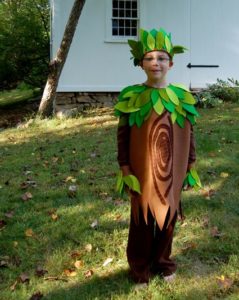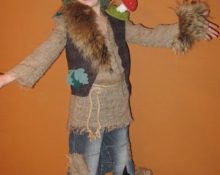 Creating a children's costume for a matinee involves a boundless flight of imagination. This could be a costume event, or it could be a whole performance, where each child has his own role.
Creating a children's costume for a matinee involves a boundless flight of imagination. This could be a costume event, or it could be a whole performance, where each child has his own role.
In children's fairy tales performed on stage, there is often the role of Oak.
Of course, you can purchase a ready-made suit, but this option has obvious disadvantages. Cheap suits on sale are usually of low quality, but for a good one you will have to pay a considerable amount.
To avoid this, you can make such a costume yourself. It will turn out to be original and suitable for the child in all respects. In addition, both parent and child participate in the creation process, which ensures joint creative time.
How to make an Oak suit
What you need for work

Old clothes can serve as the basis for the work:
- tunic or long T-shirt;
- pants or leggings;
- a cap.
If there are no suitable ready-made materials, then to create an outfit you will need:
- brown and green fabric;
- cardboard;
- threads, glue and other means of fastening.
Costume base

The main element of a boy's outfit will be brown pants. For a girl, a long straight skirt is suitable. As a top - a brown tunic or T-shirt. They will act as a tree trunk.
Important! The head should have a brown or green cap, which can be replaced with a headband with leaves.
If the suit is sewn from scratch, then As a basis, it is better to make a jumpsuit with long sleeves, the ends of which will be made in the shape of branches, and loose pants. In this case, the hat can be replaced with a hood.
However, it’s okay if the upper and lower parts are separate, the main thing is that there is no gap between them.
Creating an image

To create the image you will need leaves. They are best cut out of cardboard. Then they need to be attached to the T-shirt and hat. String them on strings or elastic bands, which should then be sewn to the base, or sew each leaf separately.
If a headband or hoop is used as a headdress, then it is better to glue cardboard leaves.
To make the tree look more realistic, cardboard leaves on the tunic should be diluted with fabric leaves, which are cut from scraps of green fabric. It's okay if they are different shades. Thus, the oak will look even more believable, because the crowns of real trees are never monochromatic.
Advice. If the time of year allows, you can attach real leaves to the headband, collected in the nearest park.

Additional attributes
Acorns

No oak tree is complete without acorns. They can decorate a suit. The easiest way to make acorns is from cardboard, then they can be glued into the “foliage”. If the costume includes a belt, then a bunch of rag or cardboard acorns will be the best decoration.
Staff
You can also make a staff in the shape of a young oak tree. To do this, you will need a piece of driftwood of the appropriate size, cleared of dust and other debris. It should be covered with scraps of green fabric (it is also advisable to cut out imitation foliage), and an acorn should be secured on top.
If time and perseverance permit, then you can cover the entire trunk of a driftwood with real acorns. It is better to leave this to the child himself. His task will be to collect the required number of acorns during a walk, and then carefully, as if in a labor lesson, paste over his future staff.
Advice. For a strong fixation, the driftwood must first be thoroughly cleaned of dust and other contaminants. It is also advisable to coat it with clear varnish.
Wreath

For complete realism the wreath can be woven from real branches, for example, willow or birch. Then they need to be decorated with decorative foliage, or they can be left as is.
bird's Nest
If a child gets the role of the Master of the Forest in a play, then an interesting solution would be to create a bird's nest on his head or shoulder. It can be woven from twigs or straw, knitted from wool, or purchased as a ready-made decorative element for the home.
Advice: If the child has rather long hair, then you can pin it up with hairpins with butterflies, dragonflies, bees and other forest inhabitants.
Thus, creating an oak costume is within the power of every parent, even if he is not used to doing needlework. Many elements can be completed by the child himself, therefore, the result is full-fledged team work.
The complexity of the costume details depends on skill and diligence. The simplest costume, taking into account the availability of a ready-made base, will take no more than an hour.But with a creative approach and the desire to add realism, the work can take a whole day.
In any case, the result will be a self-created individual image, to which the child himself had a hand. A photo in a suit will be a wonderful reminder of the holiday.


 0
0





